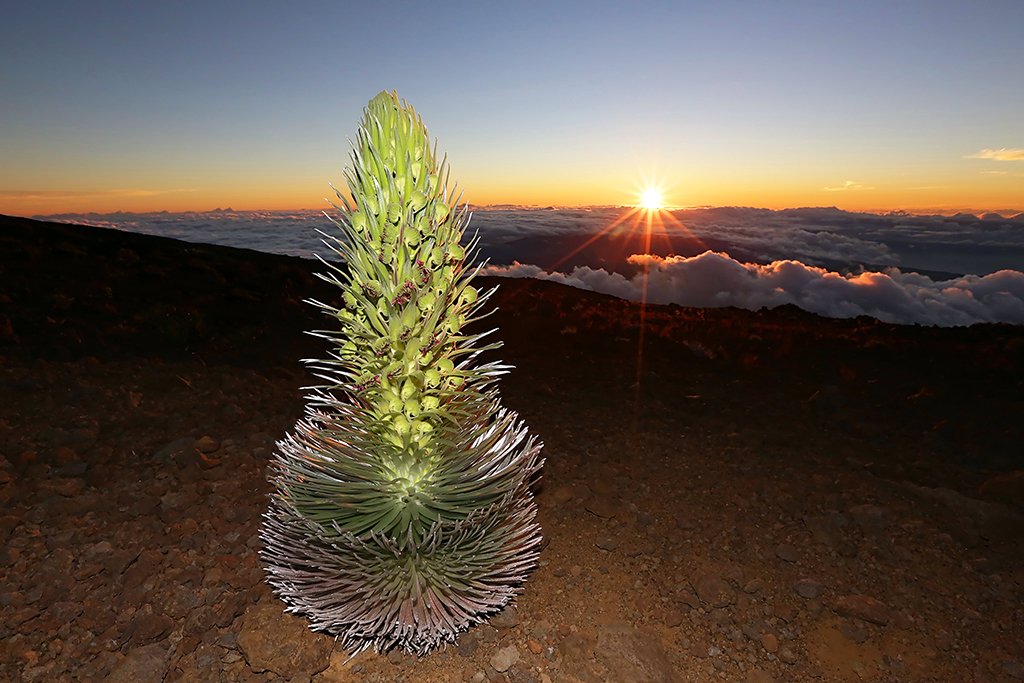02-17-2025
Hawaii Silverswords
This article may contain affiliate links. We earn a small commission at no extra cost to you. Mahalo!
Silverswords of Hawaii
Hawaiian 'Ahinahina
This unusual plant, unique to the Haleakala summit area on Maui and both Mauna Kea and Mauna Loa on the Big Island of Hawaii, just might be the rarest plant you’ll ever see. And if you do spot one in bloom, be sure to savor the moment, as it likely took decades to yield such beautiful flowers.
What is a Silversword Plant?
The Hawaiian silversword– known by its Hawaiian name 'ahinahina (“very grey”)– is an exceptionally rare and endangered plant unique to Haleakala on Maui and Mauna Kea and Mauna Loa on the Big Island of Hawaii. Because it grows at altitudes of between 5,000 and 10,000 feet (altitudes vary by island) it has thoroughly adapted to the harsh environment of its home. Its scientific name is Argyroxiphium sandwicense and it is characterized by very dense rosettes of spiky leaves that radiate out from its base. These leaves are a silvery light green color and often appear almost metallic. However, the plants' most striking feature is its towering blooms that can reach up to 6 feet in length.The bloom stalk of the silversword is a true sight to behold, often taller than its observer and adorned with a hundred or more purple flowers.
What makes the blooming of a silversword even more special is that the plants live from 15 to more than 50 years but bloom only once and die. If you see one in bloom, take a moment to realize how unique that opportunity really is!
What's even more fascinating is that each volcanic mountain has its own unique type of silversword.

Spotting a blooming silverword on Haleakala is truly breathtaking.
Grab Your Free 2025 Guides!
Hawaii Intro Visitor Guide
+ Our Summary Guidesheets!
Includes the top must-see & do attractions, best times to visit, a monthly weather & visitor summary, and our tips on how to save when booking your car rental, tours, and activities. Plus, grab our free Hawaii Summary Guidesheets. Check out our 2025 Hawaii Visitor Guides.
Types of Silverswords
When referring to the species Argyroxiphium sandwicense there are two subspecies, each of which is extremely rare and threatened. As such, they are both federally protected.
The first and perhaps most well-known silversword is of the subspecies macrocephalum and is known as the East Maui silversword, or the Haleakala silversword. The Haleakala species is unique to all the world on Maui and is considered by many to be the most beautiful.
Subspecies sandwicense is known as the Mauna Kea silversword, which is very similar to the Haleakala silversword, although its flower head is a bit narrower and it tends to yield fewer flowers.
A third close relative, the Mauna Loa silversword or Kau Silversword (Argyroxiphium kauense) can be found on the eastern and southern slopes of Mauna Loa. Fewer than 1,000 plants (and as few as 500 by some estimates) of this variety remain.
Threats to the Silversword
In the not so distant past on Maui there were so many Haleakala silverswords that they covered the ground like a blanket of snow, but because of animal grazing and visitors snapping portions for souvenirs, this amazing plant almost became extinct.
In 1927, barely 100 plants were alive on the slopes of Haleakala. It was ultimately the creation of Haleakala National Park that saved the silversword. The protection and work of several dedicated groups have brought them back from that low in 1927 to more than 40,000 Haleakala silverswords today. It is by far the most populous variety of silversword in Hawaii.
The Mauna Kea and Mauna Loa varieties have also suffered extensive decimation from animals such as goats, sheep, pigs, and cattle, but sadly their recovery has not been nearly as successful as that of the Haleakala silverswords. Conservationists are in a race against the clock to save the silverswords and botanists painstakingly cross-pollinate plants, collect seeds, and germinate them in greenhouses. Fences have also been erected to protect the fragile plants from animals and humans alike.
Climate change is another detriment to silverswords. Scientists who have been monitoring the Haleakala silverswords since the 1980’s have examined plant growth rates from various plots along with extensive climate data and have shown a link between plant population decline, increasing temperatures, solar radiation, reduced rainfall, and the number of rainy days.
Do Your Part
Even with ongoing efforts to protect the Hawaiian silverswords, these plants are still at risk. We must all do our part to ensure that these amazing plants remain for generations to come. When visiting silversword habitats, always stay on marked trails to avoid damaging their very delicate root structures or inadvertently stepping on their fragile seedlings. And of course, never touch or handle any part of the plant.
Booking tours with reputable Haleakala tour companies, such as those featured on here, also supports a network of socially-responsible tour operators who do their best to ensure the well being of both their guests as well as Hawaii’s delicate ecosystems.
You can also check out the Haleakala National Park volunteer opportunities for more information on protecting these remarkable plants.
Affiliate Disclosure: We may earn commissions from some travel partners (like Amazon or Expedia) which helps us maintain this site. These links are at no extra cost to you and don't impact our honest & unbiased recommendations. Remove all the ads →




